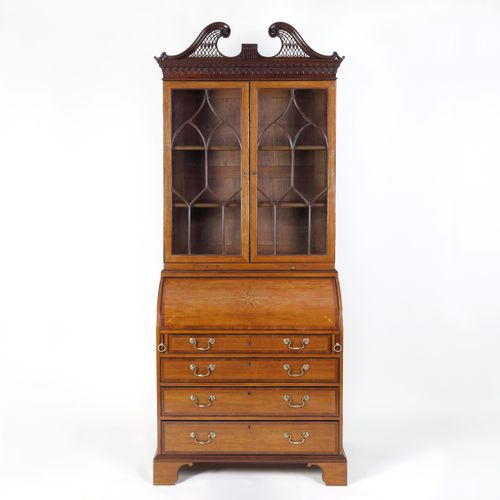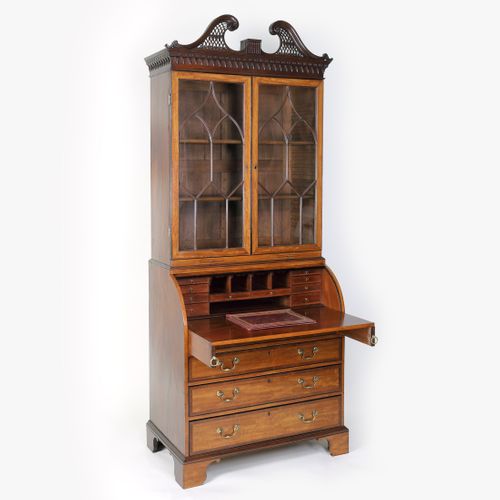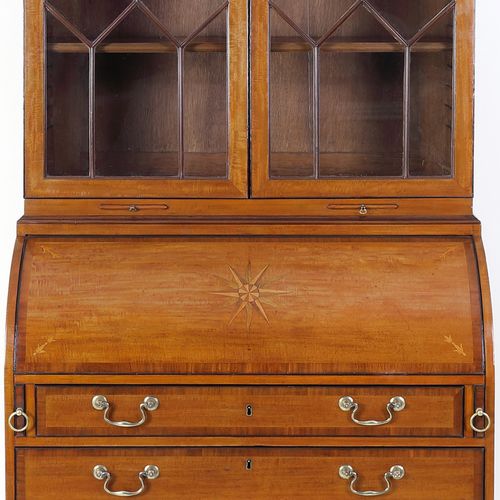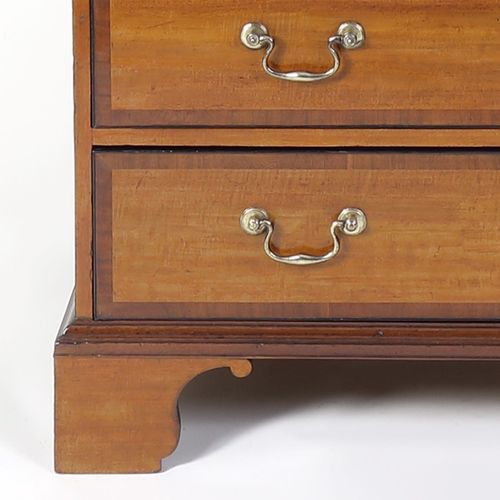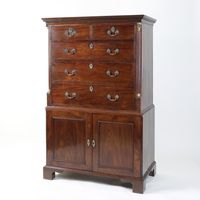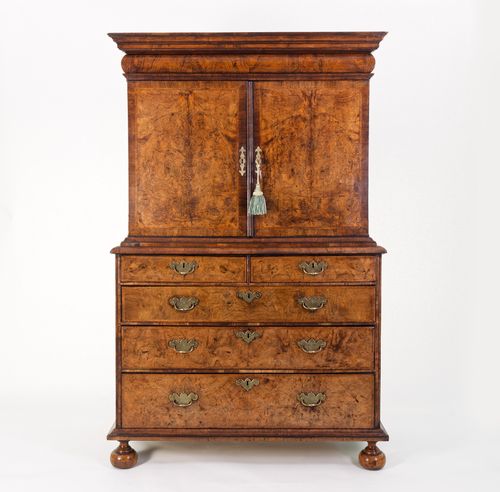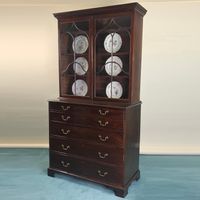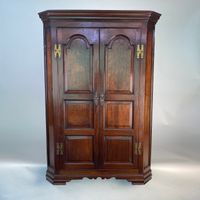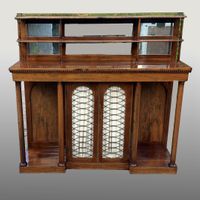Satinwood and mahogany 18th century bureau bookcase attributable to Thomas Shearer
Satinwood and mahogany 18th century bureau bookcase attributable to Thomas Shearer
Circa 1790
An exceptional and remarkable late 18th century satinwood and mahogany cylinder bureau bookcase of outstanding quality and attributable to Thomas Shearer.
This magnificent bookcase is constructed to the highest standards of craftsmanship, with superbly executed open-fret swan-neck pediment and tear-drop cornice above a pair of gothic astragal glazed doors enclosing three adjustable shelves. the lower section with a star-burst-inlaid and cross-banded cylinder enclosing a writing surface which is accessed by pulling the integral lopers that simultaneously open the cylinder and pull the writing slope forwards. This sits above four long graduated drawers, cross-banded in mahogany and edged with fine ebony cock-beading, raised on shaped bracket feet.
The richly striking tones of the satinwood are cleverly highlighted by the contrasting darker mahogany detailing which is incorporated in the cornice, the astragals the cross-banding and the moulded lower divide above the feet. The beautiful marriage of the two woods is then further accentuated by incredibly fine cock-beaded edges to the door frames, cylinder and drawer edges.
The integral lopers are a very rarely seen feature on 18th century English furniture, but are illustrated in a design drawing for a bureau bookcase by Thomas Shearer in 1788 in his book "The Cabinet Maker's London Book of Prices and Designs of Cabinet Work" issued in 1788. Further well known details of Shearers designs are the tear-drop cornice, and particular shape of the feet which are seen on other pieces known to be his work. See: Plate 296 of "English Furniture Designs of the Eighteenth Century by Peter Ward Jackson.
Thomas Shearer (fl. 1788) was an 18th-century English furniture designer and cabinet-maker.
Shearer was a craftsman and the author of most of the plates in The Cabinet Maker's London Book of Prices and Designs of Cabinet Work, issued in 1788 "for the London Society of Cabinet Makers." The majority of these plates were republished separately as Designs for Household Furniture. They exhibit their author as a man with an eye at once for simplicity of design and delicacy of proportion; some of his pieces possess a dainty and slender elegance which were a high mark in the history of English furniture.
There can be little doubt that Shearer exercised considerable influence over George Hepplewhite, with whom there is reason to suppose that he was closely associated, while Thomas Sheraton has recorded his admiration for work which has often been attributed to others. Shearer, in his turn, owes something to the Adam brothers, and something, no doubt, to the stock designs of his predecessors.
There is every reason to suppose that he worked at his craft with his own hands and that he was literally a cabinet-maker—so far as we know, he never made chairs. Much of the elegance of Shearer's work is due to his graceful and reticent employment of inlays of satinwood and other foreign woods. But he was as successful in form as in decoration, and no man ever used the curve to better purpose
This magnificent bookcase is constructed to the highest standards of craftsmanship, with superbly executed open-fret swan-neck pediment and tear-drop cornice above a pair of gothic astragal glazed doors enclosing three adjustable shelves. the lower section with a star-burst-inlaid and cross-banded cylinder enclosing a writing surface which is accessed by pulling the integral lopers that simultaneously open the cylinder and pull the writing slope forwards. This sits above four long graduated drawers, cross-banded in mahogany and edged with fine ebony cock-beading, raised on shaped bracket feet.
The richly striking tones of the satinwood are cleverly highlighted by the contrasting darker mahogany detailing which is incorporated in the cornice, the astragals the cross-banding and the moulded lower divide above the feet. The beautiful marriage of the two woods is then further accentuated by incredibly fine cock-beaded edges to the door frames, cylinder and drawer edges.
The integral lopers are a very rarely seen feature on 18th century English furniture, but are illustrated in a design drawing for a bureau bookcase by Thomas Shearer in 1788 in his book "The Cabinet Maker's London Book of Prices and Designs of Cabinet Work" issued in 1788. Further well known details of Shearers designs are the tear-drop cornice, and particular shape of the feet which are seen on other pieces known to be his work. See: Plate 296 of "English Furniture Designs of the Eighteenth Century by Peter Ward Jackson.
Thomas Shearer (fl. 1788) was an 18th-century English furniture designer and cabinet-maker.
Shearer was a craftsman and the author of most of the plates in The Cabinet Maker's London Book of Prices and Designs of Cabinet Work, issued in 1788 "for the London Society of Cabinet Makers." The majority of these plates were republished separately as Designs for Household Furniture. They exhibit their author as a man with an eye at once for simplicity of design and delicacy of proportion; some of his pieces possess a dainty and slender elegance which were a high mark in the history of English furniture.
There can be little doubt that Shearer exercised considerable influence over George Hepplewhite, with whom there is reason to suppose that he was closely associated, while Thomas Sheraton has recorded his admiration for work which has often been attributed to others. Shearer, in his turn, owes something to the Adam brothers, and something, no doubt, to the stock designs of his predecessors.
There is every reason to suppose that he worked at his craft with his own hands and that he was literally a cabinet-maker—so far as we know, he never made chairs. Much of the elegance of Shearer's work is due to his graceful and reticent employment of inlays of satinwood and other foreign woods. But he was as successful in form as in decoration, and no man ever used the curve to better purpose
H 233.50cm (91.93 inches)
W 91.50cm (36.02 inches)
D 54.50cm (21.46 inches)
W 91.50cm (36.02 inches)
D 54.50cm (21.46 inches)
£42,000.00



